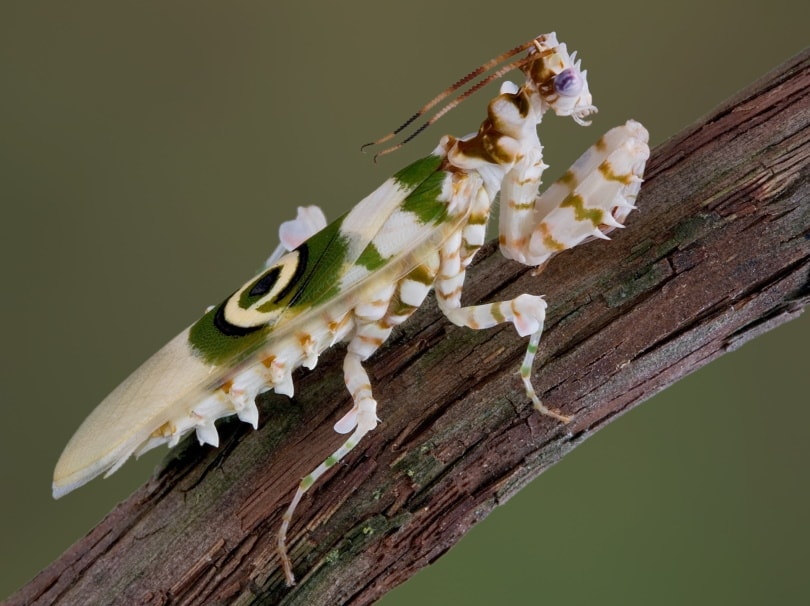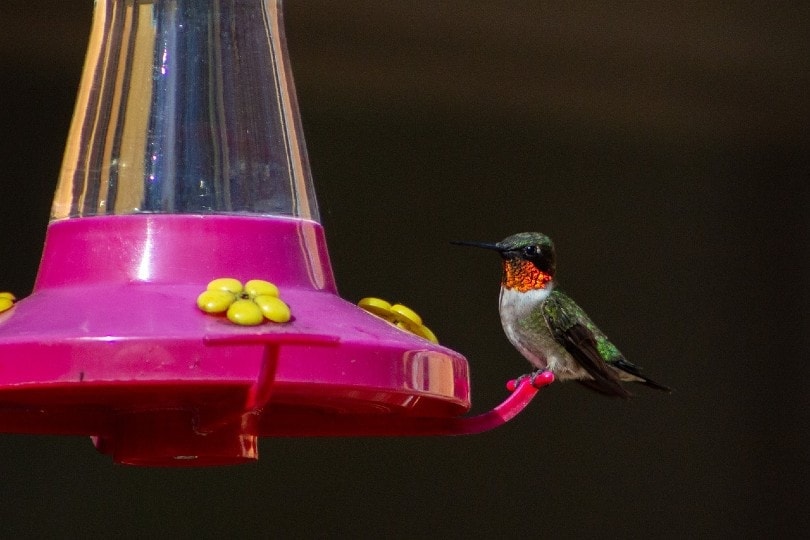Do Praying Mantis Kill Hummingbirds? What You Need To Know!
Last Updated on

The praying mantis is an order of insects, of which there are nearly 2,000 different species, that are easily recognized by the praying position of the front legs. They are carnivorous and while they do pose a threat to some of the insects and small animals in your garden, they are welcomed by a lot of gardeners because they eat insect pests. However, larger praying mantises are capable of and will successfully eat hummingbirds.
As well as their posture, which looks as though they are bowing in prayer, the female mantis is known for cannibalizing their mate during or after sex, and they do so in the same way that they eat their prey – headfirst.
Read on to find out more about the praying mantis, its dining habits, and what you can do to protect the hummingbirds in your garden.

About Praying Mantis

The praying mantis, or mantis religiosa, is a carnivorous invertebrate. It will usually one year in the wild and has a body that looks like a twig or leaf. Its head is triangular, and it has large eyes that are usually the same color as its head. The mantis has a 180° field of view.
Adult praying mantids can grow to 6 inches in length, although not all reach this size. They are formidable hunters, agile athletes, and some mantises naturally disguise themselves as flowers while others will molt and change their color to coincide with bush fires and other natural occurrences.
How They Hunt
The insect is designed to hunt, and it is a highly skilled predator. Unusually for an insect, it has a head that will turn independently of its body, allowing it to more easily sneak up on its quarry. It exclusively eats live food, which means no vegetables or plant-based food for the praying mantis, and it also means that they will not scavenge already dead insects.
Although they are skilled hunters, they do not escape predation themselves. Lizards, frogs, and some birds will happily snack on one of these invertebrates. They are also hunted by bats, but they have the incredible ability to detect a bat’s echolocation and when they sense one approach, they will spiral and, if caught, they will attempt to slash the bat with their sharp legs to get free.
The insect will wait and stalk its victim patiently until it spies an opening. When it does recognize that it’s time to strike, the mantis will attack quickly and with purpose. It uses its strong front legs, which also have sharp spikes, to hold its victim in place, and then start to eat the headfirst before moving on to devour the rest of its prey.

What They Eat
Their hunting method sounds vicious, but it is also highly effective. On average, one mantis will eat approximately 7 insects a day, equivalent to about 1,000 over the insect’s lifetime. This means a lot of hunting. Its appetite and its impressive hunting capabilities also make the praying mantis an ambitious hunter that will attempt to take down larger animals.
As well as insects like flies and moths, and even sometimes small snakes, lizards, and frogs, the mantis will try and take down the hummingbird.
Praying Mantises and Hummingbirds
For those that put out hummingbird feeders, the threat of the praying mantis is real, and witnessing one devour this tiny bird can be a gruesome sight that is best avoided.
These two creatures are approximately the same size, being approximately 4 inches long, although the hummingbird is certainly bigger than the mantis’s usual meal. The mantis is also often found at the hummingbird feeder because insects like bees and wasps, which are a staple part of their diet, are attracted to the sugary water that is left out for the birds.
Experts believe that the praying mantis will only strike at a hummingbird if it is hungry and is struggling to find food because they base their decision of what to hunt on the difficulty of catching it and how hungry they are. A hummingbird is fast and difficult to catch as well as being large. The mantis will not be able to eat the whole hummingbird, so it will not usually view this as a worthwhile hunt. However, hunger makes them willing to take greater risks.
How Do I Keep Praying Mantis Off My Hummingbird Feeder?
Avoid using insecticides because these can kill other insects and may even prevent birds from coming to your feeder. If you see a mantis on your hummingbird feeder, use a stick and encourage the insect onto the stick by gently pushing it under their legs. Place it gently on the ground away from the feeder.
Try to place hummingbird feeders away from bushes and trees. Mantises are very good at disguising themselves so that they can sneak up more effectively on their prey, hence why many are shaped like twigs and leaves.
You can also try placing a larger feed cover over the top of your hummingbird feeder. This will deter those mantids that cannot fly but may not completely eradicate the problem because some are capable of flight.

Do Praying Mantis Eat Wasps?
Mantids are not bad, and they are welcomed to gardens by a lot of gardeners because they do eat insects that could be potentially damaging to crops and flowers. They eat moths, at night, for example. But they do not discriminate, and they will also eat potentially beneficial insects like bees and wasps. In fact, wasps are a regular prey insect for the praying mantis.
Are Praying Mantis Safe to Hold?
Praying mantis are formidable hunters and they can take down hummingbirds, although it is rare. They do so using their sharp legs. They are not venomous, and they don’t bite. They also judge whether it is worth attacking potential prey according to various factors, including size and the likelihood of a successful kill.
As such, they are very unlikely to try and take a piece out of your finger. In fact, they are considered good insect pets because they are usually quite tolerant of being handled and enjoy walking from hand to hand.
Related Read: 10 Proven Ways to Keep Bees OUT of Hummingbird Feeders

Do Praying Mantis Kill Hummingbirds?
The praying mantis is a fascinating insect with some unique habits: some of which might be considered quite gross. They are capable hunters and will eat six or seven flies a day, in most cases. They can even kill hummingbirds, but they also make good pets because they are quiet around humans while also enjoying walking from hand to hand while being handled.
To avoid hummingbirds falling foul to this invertebrate hunter in your garden, consider the careful placement of the feeder and use a stick to gently encourage the mantis to another area of the garden if you do spot one on the feeder.
Featured Image Credit By Cathy Keifer, Shutterstock
About the Author Robert Sparks
Robert’s obsession with all things optical started early in life, when his optician father would bring home prototypes for Robert to play with. Nowadays, Robert is dedicated to helping others find the right optics for their needs. His hobbies include astronomy, astrophysics, and model building. Originally from Newark, NJ, he resides in Santa Fe, New Mexico, where the nighttime skies are filled with glittering stars.
Related Articles:
Can You Use Binoculars to Look At Stars? How to Choose the Right Pair
How to Clean a Refractor Telescope: Step-by-Step Guide
How to Clean a Telescope Eyepiece: Step-by-Step Guide
How to Clean a Rifle Scope: 8 Expert Tips
Monocular vs Telescope: Differences Explained (With Pictures)
What Is a Monocular Used For? 8 Common Functions
How to Clean a Telescope Mirror: 8 Expert Tips
Brightfield vs Phase Contrast Microscopy: The Differences Explained
